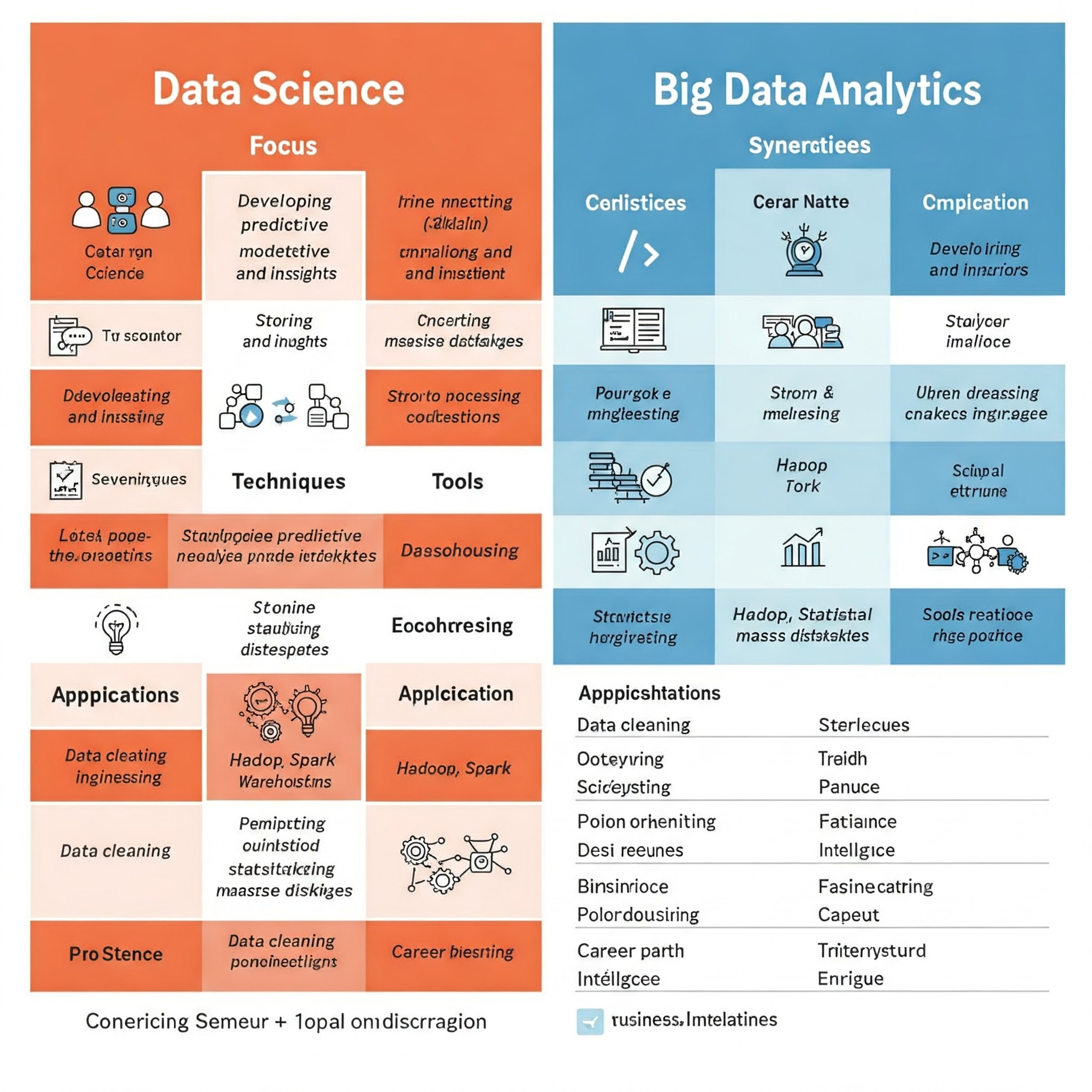The blog is structured to take readers through:
- The evolution of data analytics and why it matters
- Core technical skills including programming languages, statistics, and data engineering
- Big data technologies like cloud platforms, distributed computing, and storage solutions
- Visualization and communication tools for presenting insights effectively
- Industry-specific applications in healthcare, finance, and marketing
- Practical advice for building experience and continuous learning
- Future trends including AI integration and ethical considerations
In today’s data-driven world, the ability to extract meaningful insights from vast amounts of information has become one of the most valuable skills across industries. Data science and big data analytics have evolved from niche technical fields into essential business capabilities that drive decision-making, innovation, and competitive advantage. Whether you’re a seasoned professional looking to upskill or a newcomer eager to enter this dynamic field, understanding the landscape of modern data analytics is crucial for success.
The Evolution of Data Analytics
The transformation of data analytics over the past decade has been remarkable. Traditional business intelligence tools that once handled structured data in manageable volumes have given way to sophisticated platforms capable of processing petabytes of diverse data types in real-time. This evolution has been driven by the exponential growth of data generation, advances in computing power, and the democratization of machine learning technologies.
Modern organizations generate data from countless sources including social media interactions, IoT sensors, mobile applications, e-commerce transactions, and customer service interactions. This data deluge has created both opportunities and challenges, requiring analysts to develop new skills and master emerging tools to remain effective in their roles.
Essential Technical Skills for Modern Data Scientists
Programming Languages
Python and R remain the cornerstone programming languages for data science, each offering unique advantages. Python’s versatility makes it ideal for end-to-end data science workflows, from data collection and cleaning to model deployment and web application development. Its extensive ecosystem includes powerful libraries like Pandas for data manipulation, NumPy for numerical computing, Scikit-learn for machine learning, and TensorFlow or PyTorch for deep learning.
R continues to excel in statistical analysis and data visualization, with packages like ggplot2 setting the standard for publication-quality graphics. The language’s statistical heritage makes it particularly valuable for hypothesis testing, experimental design, and advanced statistical modeling.
SQL proficiency remains non-negotiable for data professionals. Modern SQL has evolved beyond basic queries to include window functions, common table expressions, and JSON processing capabilities. Understanding how to optimize queries for performance and work with different database systems is essential for handling large datasets efficiently.
Statistical Foundation and Machine Learning
A solid understanding of statistics forms the backbone of effective data analysis. This includes descriptive statistics, probability distributions, hypothesis testing, regression analysis, and experimental design. These fundamentals enable analysts to make valid inferences from data and communicate findings with appropriate confidence levels.
Machine learning knowledge has become increasingly important, spanning supervised learning algorithms like linear regression, decision trees, and neural networks, as well as unsupervised techniques such as clustering and dimensionality reduction. Understanding when to apply different algorithms and how to evaluate their performance is crucial for building reliable predictive models.
Data Engineering Fundamentals
Modern data scientists must understand data engineering principles to work effectively with big data systems. This includes knowledge of distributed computing concepts, data pipeline design, and ETL processes. Familiarity with containerization technologies like Docker and orchestration tools like Kubernetes has become valuable for deploying and scaling data science solutions.
Big Data Technologies and Platforms
Cloud Computing Platforms
Amazon Web Services, Microsoft Azure, and Google Cloud Platform have revolutionized how organizations store, process, and analyze data. These platforms offer managed services that eliminate much of the infrastructure complexity traditionally associated with big data projects. Services like AWS Redshift, Azure Synapse Analytics, and Google BigQuery provide scalable data warehousing solutions, while machine learning services like AWS SageMaker and Google Cloud AI Platform streamline model development and deployment.
Distributed Computing Frameworks
Apache Spark has emerged as the de facto standard for big data processing, offering APIs in Python, Scala, and Java. Its ability to handle both batch and streaming data processing makes it versatile for various analytical workloads. Understanding Spark’s architecture and optimization techniques is essential for processing large datasets efficiently.
Apache Kafka has become the backbone of real-time data streaming in many organizations, enabling the processing of millions of events per second. Data scientists working with streaming data need to understand Kafka’s concepts and how to integrate it with analytical workflows.
Data Storage Solutions
The choice between relational databases, NoSQL databases, and data lakes depends on specific use cases and requirements. PostgreSQL and MySQL remain popular for structured data, while MongoDB and Cassandra excel with unstructured data. Data lakes built on technologies like Apache Hive and Apache Iceberg provide flexible storage for diverse data types while maintaining query performance.
Visualization and Communication Tools
Advanced Visualization Platforms
Tableau and Power BI have democratized data visualization, enabling analysts to create interactive dashboards and reports without extensive programming knowledge. These tools excel at exploratory data analysis and business reporting, offering drag-and-drop interfaces that make complex visualizations accessible to non-technical users.
For more customized and programmatic visualizations, libraries like D3.js, Plotly, and Bokeh provide greater flexibility and control. These tools are particularly valuable for creating interactive web-based visualizations and embedding analytics into applications.
Emerging Visualisation Technologies
Augmented reality and virtual reality technologies are beginning to find applications in data visualization, particularly for exploring complex multidimensional datasets. While still emerging, these technologies offer promising opportunities for immersive data exploration and presentation.
Industry-Specific Applications and Specializations
Healthcare Analytics
Healthcare data science requires specialized knowledge of medical terminology, regulatory requirements like HIPAA compliance, and clinical research methodologies. Electronic health records, medical imaging, and genomic data present unique analytical challenges and opportunities for improving patient outcomes and operational efficiency.
Financial Services
Financial analytics demands understanding of risk management principles, regulatory compliance requirements, and real-time processing capabilities for fraud detection and algorithmic trading. Time series analysis and anomaly detection are particularly important skills in this domain.
Marketing and Customer Analytics
Customer behavior analysis, recommendation systems, and marketing attribution modeling require deep understanding of consumer psychology and business metrics. A/B testing methodologies and customer lifetime value modeling are essential skills for marketing analysts.
Building Practical Experience
Portfolio Development
Creating a strong portfolio of data science projects demonstrates practical skills to potential employers. Effective projects should showcase end-to-end capabilities, from data collection and cleaning through analysis and visualization to actionable insights. Contributing to open-source projects and participating in data science competitions like those on Kaggle can provide valuable experience and community recognition.
Continuous Learning Strategies
The rapid pace of change in data science requires commitment to continuous learning. Following industry blogs, attending conferences, and participating in online communities help professionals stay current with emerging trends and technologies. Platforms like Coursera, edX, and Udacity offer specialized courses and certification programs that can help validate skills and knowledge.
The Future Landscape
Artificial Intelligence Integration
The integration of large language models and generative AI into data science workflows is transforming how analysts approach problem-solving. Tools like GitHub Copilot are already assisting with code generation, while GPT-based models are being used for data analysis and report generation. Understanding how to leverage these AI tools effectively while maintaining analytical rigor will become increasingly important.
Automated Machine Learning
AutoML platforms are making machine learning more accessible to non-experts while allowing experienced practitioners to focus on higher-level strategic problems. However, understanding the underlying algorithms and their limitations remains crucial for ensuring reliable results and appropriate model selection.
Ethical Considerations and Responsible AI
As data science applications become more pervasive, understanding ethical implications and bias mitigation techniques becomes essential. Data scientists must consider fairness, transparency, and accountability in their models and analyses, particularly when working with sensitive data or making decisions that affect individuals’ lives.
Conclusion
Mastering data science and big data analytics requires a combination of technical skills, domain knowledge, and business acumen. The field continues to evolve rapidly, with new tools and techniques emerging regularly. Success requires not only proficiency with current technologies but also the ability to adapt and learn continuously.
The most effective data scientists combine strong technical foundations with excellent communication skills and business understanding. They can translate complex analytical findings into actionable insights that drive organizational success. As the volume and complexity of data continue to grow, the demand for skilled data professionals will only increase, making this an exciting and rewarding career path for those willing to invest in developing these critical skills.
The journey to becoming a proficient data scientist is challenging but rewarding. By building a strong foundation in the core skills and tools outlined in this guide, staying current with emerging technologies, and gaining practical experience through real-world projects, aspiring data professionals can position themselves for success in this dynamic and impactful field.
At 7Shades Digital, we specialised in creating strategies that help businesses excel in the digital world. If you’re ready to take your website to the next level, contact us today!





